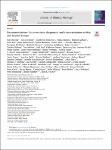Recommendations for enterovirus diagnostics and characterisation within and beyond Europe
Harvala, Heli
Broberg, Eeva
Benschop, Kimberley
Berginc, Natasa
Ladhani, Shamez
Susi, Petri
Christiansen, Claus
McKenna, James
Allen, David
Makiello, Phoebe
McAllister, Georgina
Carmen, Mirabelli
Zakikhany, Katherina
Dyrdak, Robert
Nielsen, Xiaohui
Madsen, Tina
Paul, Joel
Moore, Catherine
von Eije, Karin
Piralla, Antonio
Carlier, Mieke
Vanoverschelde, Laura
Poelman, Randy
Anton, Andrés
López-Labrador, F. Xavier
Pellegrinelli, Laura
Keeren, Kathrin
Maier, Melanie
Cassidy, Hayley
Derdas, Stavros
Savolainen-Kopra, Carita
Diedrich, Sabine
Nordbø, Svein
Buesa, Javier
Bailly, Jean-Luc
Baldanti, Fausto
MacAdam, Andrew
Mirand, Audrey
Dudman, Susanne
Schuffenecker, Isabelle
Kadambari, Seilesh
Neyts, Johan
Griffiths, Michael J.
Richter, Jan
Margaretto, Christina
Govind, Sheila
Morley, Ursula
Adams, Ortwin
Krokstad, Sidsel
Dean, Jonathan
Pons-Salort, Margarita
Prochazka, Birgit
Cabrerizo, Maria
Majumdar, Manasi
Nebbia, Gaia
Wiewel, Maryse
Cottrell, Simon
Coyle, Peter
Martin, Javier
Moore, Catrin
Midgley, Sofie
Horby, Peter
Wolthers, Katja
Simmonds, Peter
Niesters, Hubert
Fischer, Thea K.
Enteroviruses (EV) can cause severe neurological and respiratory infections, and occasionally lead to devastating outbreaks as previously demonstrated with EV-A71 and EV-D68 in Europe. However, these infections are still often underdiagnosed and EV typing data is not currently collected at European level. In order to improve EV diagnostics, collate data on severe EV infections and monitor the circulation of EV types, we have established European non-polio enterovirus network (ENPEN). First task of this cross-border network has been to ensure prompt and adequate diagnosis of these infections in Europe, and hence we present recommendations for non-polio EV detection and typing based on the consensus view of this multidisciplinary team including experts from over 20 European countries. We recommend that respiratory and stool samples in addition to cerebrospinal fluid (CSF) and blood samples are submitted for EV testing from patients with suspected neurological infections. This is vital since viruses like EV-D68 are rarely detectable in CSF or stool samples. Furthermore, reverse transcriptase PCR (RT-PCR) targeting the 5′noncoding regions (5′NCR) should be used for diagnosis of EVs due to their sensitivity, specificity and short turnaround time. Sequencing of the VP1 capsid protein gene is recommended for EV typing; EV typing cannot be based on the 5′NCR sequences due to frequent recombination events and should not rely on virus isolation. Effective and standardized laboratory diagnostics and characterisation of circulating virus strains are the first step towards effective and continuous surveillance activities, which in turn will be used to provide better estimation on EV disease burden.
Dateien zu dieser Publikation

